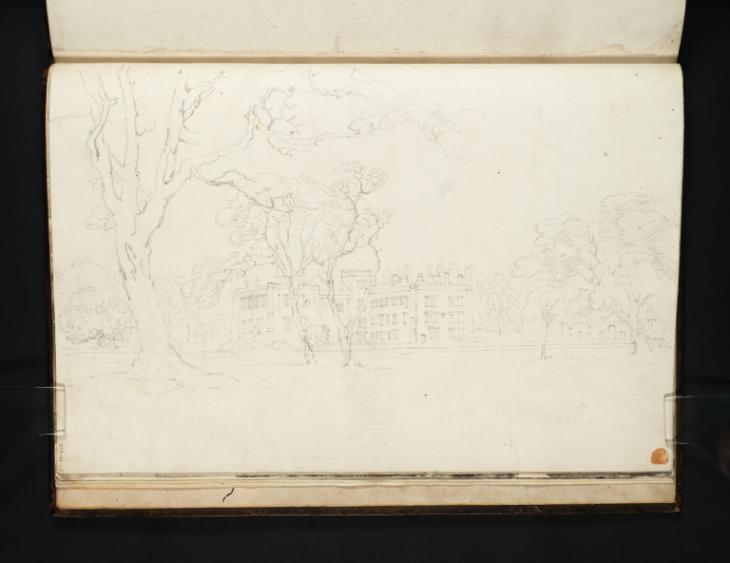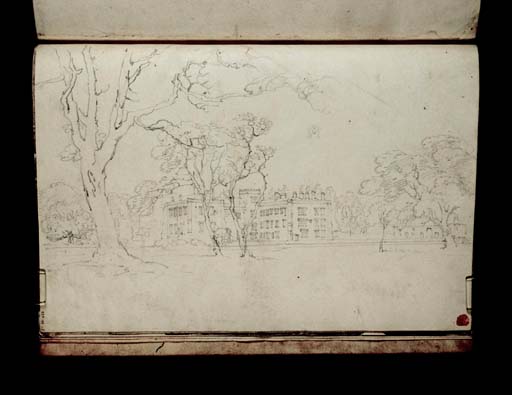Joseph Mallord William Turner Towneley Hall, near Burnley, Lancashire, from the South-East 1799
Image 1 of 2
Joseph Mallord William Turner,
Towneley Hall, near Burnley, Lancashire, from the South-East
1799
Joseph Mallord William Turner 1775–1851
Folio 46 Recto:
Towneley Hall, near Burnley, Lancashire, from the South-East 1799
D01985
Turner Bequest XLV 45
Turner Bequest XLV 45
Pencil on white wove paper, 225 x 329 mm
Inscribed by Turner in pencil ‘3’ and ‘W’ in the drawing
Blind-stamped with Turner Bequest monogram bottom right
Inscribed in pencil ‘45’ bottom left, descending vertically
Stamped in black ‘XLV-45’ bottom left, descending vertically
Inscribed by Turner in pencil ‘3’ and ‘W’ in the drawing
Blind-stamped with Turner Bequest monogram bottom right
Inscribed in pencil ‘45’ bottom left, descending vertically
Stamped in black ‘XLV-45’ bottom left, descending vertically
Accepted by the nation as part of the Turner Bequest 1856
References
1909
A.J. Finberg, A Complete Inventory of the Drawings of the Turner Bequest, London 1909, vol.I, p.113, XLV 45, as ‘Townley Hall. ... On back – “St. Gillum Henrie.”’ c.1799.
1975
Malcolm Cormack, J.M.W. Turner, R.A. 1775–1851: A Catalogue of Drawings and Watercolours in the Fitzwilliam Museum, Cambridge, Cambridge 1975, p.34 under no.9.
1982
Stanley Warburton, Turner and Dr. Whitaker, exhibition catalogue, Towneley Hall Art Gallery & Museums, Burnley 1982, p.27, under nos.10 and 11.
A detail of a pediment is studied above the centre of the main view, made with the page turned horizontally, which was the basis for the finished watercolour (Towneley Hall Art Gallery, Burnley),1 engraved in 1800 for Thomas Dunham Whitaker’s History of Whalley (Tate impression: T05932), and probably first owned by Charles Townley (sic; 1737–1805), a Lancashire patron whose support was no doubt of considerable importance for Turner. Townley was famous for having brought together one of the best-known of all late eighteenth-century collections of classical marbles; they were purchased after his death by the British Museum. Towneley Hall, which now owns Turner’s watercolour, also possesses Johann Zoffany’s famous painting of 1781–3 showing Townley surrounded by his collection in his London house, 7 Park Street (14 Queen Anne’s Gate), Westminster.2
Verso:
Inscribed in pencil ‘SIGILLVM HENRIC’. This inscription, which is probably in Turner’s hand, seems to transcribe part of the lettering on one of the Whalley Abbey seals in a watercolour (Fitzwilliam Museum, Cambridge).1 Malcolm Cormack seems to imply that the writing is not Turner’s, describing it as ‘the same hand as that on the inscription for Henry De Lacy’2 in the Fitzwilliam work; the reference, however, is not clear. Although the watercolour groups fourteen seals together (or fifteen: one comprises two linked elements), James Basire’s 1800 engraving Seals of Whalley Abbey, plate III in volume I of Whitaker’s History of Whalley (no Tate impression), includes only seven of the items, combining them with others which Turner must have drawn on a now lost sheet; none of the seals actually includes the name ‘Henrici’ though ‘sigillum’ (i.e. seal) is present on several. Another engraving, Seals of the Lords of Blackburnshire (volume I, plate X), includes the remaining seven.3
The seals are those of church officials connected with Whalley, including the Bishop of Lichfield, patron of the living of Whalley, and of the de Lacy family, who possessed land in this region. A further sheet of watercolour drawings showing antiquities from Whalley contains studies of stone crosses, brasses and misericords (Towneley Hall Art Gallery, Burnley);4 it was engraved in 1800 as plate Iv in volume I (Tate impression: T05926).
Andrew Wilton
May 2013
How to cite
Andrew Wilton, ‘Towneley Hall, near Burnley, Lancashire, from the South-East 1799 by Joseph Mallord William Turner’, catalogue entry, May 2013, in David Blayney Brown (ed.), J.M.W. Turner: Sketchbooks, Drawings and Watercolours, Tate Research Publication, April 2016, https://www


